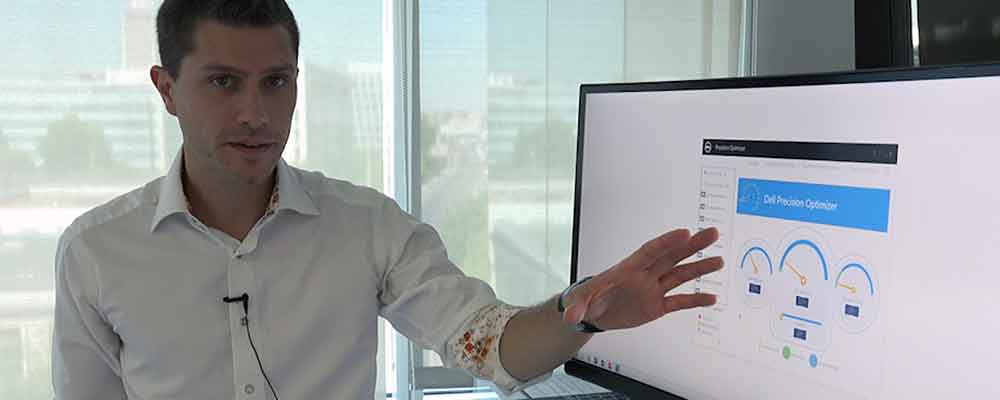 Every workstation can be tuned for the best performance on a particular application. But what about multiple applications? And can you do that? Automatically? Easily? Check out the Dell Performance Optimizer for your workstation.
Every workstation can be tuned for the best performance on a particular application. But what about multiple applications? And can you do that? Automatically? Easily? Check out the Dell Performance Optimizer for your workstation.
Here is the issue – a professional workstation uses powerful technology for graphics, processors, memory, and storage. You want to get the most performance possible out of your hardware and you use demanding applications that need that performance.

Mostly, you are on your own. Maybe one of the gurus in you office knows a trick or two. Maybe you know a couple of tricks yourself. Or maybe you just use the factory settings and hope for the best.
If you want to tune your workstation, your options include using the factory settings or tweaking the settings by hand - where you can. You can try to keep your BIOS & drivers up-to-date. And you can hope that your changes actually improve the performance while working in any one of your key applications.
Can you adjust your workstation's graphics, processors, memory, and BIOS settings to get the best performance on just one of your applications?
My guess is that the vast majority of you use the factory settings and try to keep your drivers more-or-less up-to-date. I would also guess that some much smaller number of you have found one or more settings in the BIOS configuration or in the graphics configuration tool which helps one, maybe two of your applications perform better on that one workstation you use every day.
That's far from the ideal situation. You and I know that your workstation is packed full of great technology. Our applications are mostly high-end software for design, engineering, simulation, rendering, video, etc. Most of us have one or more tasks which bring our workstation to its knees – and we would love to know that we are getting every ounce of performance from our system.

CADplace sat down with Dell France's Precision Workstation Business Manager, Benoit Bastien, for an in-depth discussion on Dell's Precision Performance Optimizer (image : Tom Lansford)
Dell knows this too. They know that all of us want the best performance possible from our workstation because we need it to be as productive, competitive, and profitable as possible.
And Dell knows that they are uniquely positioned to deliver the tools to optimize the workstation for the applications we use. Not only does Dell control every detail of the technology in a Precision workstation, they also test and certify the workstation for these same professional applications.
So Dell added a team of dedicated performance engineers to the mix and developed a unique tool for Precision Workstations called the Dell Precision Performance Optimizer.
Dell has a dedicated team of engineers supporting the Dell Performance Optimizer
Now, this is pretty cool. Basically you select the applications that you use from the list of performance profiles created by the Dell team and your workstation will be configured in every way possible to get the most out of your workstation for the applications you use.
Simple. Easy. But the best part is that the DPO does more. And some of it's features will have you asking why no one did this before.
The Dell Precision Performance Optimizer can be divided into four parts:
- Automatic performance optimization
- System management
- System analysis and reporting
- Direct link to Dell
The Dell Precision Performance Optimizer interface

The home-screen for the DPO is dominated by the real-time gauges for graphics, processors, memory and storage. It has performance profiles for your software applications on the left side and tabs for system management, analysis, reporting, etc, across the top.
The application performance profiles on the left are the raison d'être for the DPO. Just click on the applications that you use and the status of the profile will change to “On”. The system should be restarted for the configuration to be completed. From that point on, the system monitors your activity and when you launch one of the selected applications, the optimizations will kick-in.
That was easy. Thanks to the DPO, the workstation will run with the best settings for each application.
Skipping down to the reporting feature, Dell provides a window to the Dell engineers via the DPO tool. You can communicate issues and ideas directly to Dell. For example, if you have additional performance profiles you need, you can tell Dell. This feedback tool can be completely anonymous or your can provide contact information. Dell has always claimed to be close to their customers, and with this tool in the DPO, they have created a communication path for every customer.
The systems management feature helps you keep the system running with the latest updates. This is particularly useful if you don't have an IT department updating your workstation for you.

First of all, the systems management function provides you with updates relevant to your system and it's specific configuration. You only see updates for drivers, the BIOS, application profiles, and firmware which apply to your system. Secondly, the updates are ordered by critical priority which helps you choose the updates you want.
Third, the systems management function provides customers with a “health report” on the system. System checks verify that the workstation is running properly and the results can alert you to potential issues.
In the end, this function assures you that your system, with it's particular configuration, is up-to-date and running well.
I saved the system analysis and reporting feature for last. In my opinion, this is the hidden gem in the Dell Performance Optimizer. It's divided into two parts.
The first allows you to generate reports on the system – extremely complete reports. You will see a full list of components and reports on system sensors. For example, you will see thermal analysis with data on temperatures and fans, overall system analysis for processors, memory, graphics, etc.
The workload analysis feature is the hidden gem in the Dell Precision Performance Optimizer.

The second part allows you to run analyses of the system workload. Setup an analysis, and then go to work. Work for one hour. Work all morning. Or work all day. In the end, the analysis shows how your system was used in an easy to view, graphical report. This allows you to identify performance bottlenecks in your system and in your working environment.
The report shows the level of saturation for graphics, processors, memory, etc. You might find that your graphics and memory are used to their maximum capacity but your processors are underutilized. The result might lead you to change change your graphics and add memory to remove these performance bottlenecks. Or it can help you adapt the configuration for your next workstation replacement cycle.
The workload analysis feature is truly the hidden gem in the Dell Precision Performance Optimizer. Yes, the primary reason for the DPO is to easily maximize performance with your applications. And the DPO will adapt your system to get the most performance from your applications – using the current workstation configuration!
But if your workstation itself is poorly configured for your projects, then knowing exactly where and how to change your configuration is worth it's weight in gold. The workload analysis points you toward configuration changes which can remove bottlenecks and give you a performance boost based on your highly individual and unique work.
Since you know precisely which systems to change, you upgrade your workstation efficiently and cost-effectively. You simultaneously improve performance and save money.
Why can Dell do this in the first place?
To wrap up our look at the Dell Performance Optimizer, let's ask the question : why is Dell able to do this?

Dell's Benoit Bastien, Precision Workstation Business Manager, explains the features, benefits, and background of the Dell Performance Optimizer (image : Tom Lansford)
Dell's development team controls the entire workstation functional environment. Dell's performance engineers are intimately familiar with the workstation operating system and the professional applications. And Dell has been working closely with professional software application developers (ISVs, Independent Software Vendors) since the Dell Precision professional workstation was first created.
That is the foundation. To optimize Precision workstations and to create the performance profiles, Dell works closely with the ISVs. They use the experience and recommendations of the software developers. Dell also uses the performance and benchmarking tools used by the ISVs themselves.
Dell performance engineers can then look at adapting settings in the workstation BIOS, in the Windows operating system, in the graphics driver settings, and more. They can adapt the power configuration, adapt the number of active CPU cores, and adjust the hyper-threading settings. Dell then applies this information and runs hours of tests on the workstations to verify the best configuration.
The results of this effort are application performance profiles for Dell Precision workstations which are based on engineering data and performance testing. This work ensures you that you will get the most from your workstation.
If you use Dell Precision Workstations, then you should be using the Dell Precision Performance Optimizer
The fact that the DPO gives you the best configurations for your applications, that it does so automatically, and that it is so simple to use are all great reasons to use this software. And the systems management tools help keep your workstation running smoothly – especially for those of us without an expert IT department. The option to start a dialog directly with Dell engineers is a forward-thinking and customer-oriented feature.
But if you are not only interested in getting the most out of your current workstation, but also interested in having the best configuration for your workloads, then your hidden gem in the DPO is the workload analysis feature. With it in hand, you will adapt, upgrade and customize your workstation to be the best performing, most cost-effective system possible.





